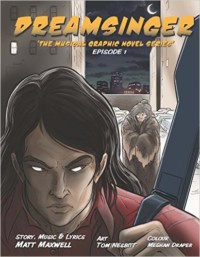Title: Dreamsinger: Episode 1
Author: Matt Maxwell
Illustrator: Tom Nesbit and Meghan Draper
Publisher: Dreamsinger Productions
ISBN: 978-009950879-0-3
Pages: 50
Genre: Graphic Novel
Reviewed by: Thomas Macolino
Buy Book on Amazon
Pacific Book Review
The beauty and strength of the graphic novel is its ability to blend text and image to create something greater than its separate parts. Matt Maxwell’s graphic novel “Dreamsinger” attempts to take this a step further and, in a bold move, adds music into the mix. The first episode introduces the aptly named, John “Toney,” a Native American musician hoping to one day hit it big. But when he gets his wish, his happiness is undercut by the appearance of a strange homeless woman who warns him of an impending danger that relates to both his musical talent and his strangely lucid dreams. The blending of the mundane and the fantastical in this graphic novel is well done, with both plotlines pulling you forward on their own whilst likewise supplementing each other.
Maxwell has taken a bold first step. Crafting a piece of storytelling using image, text and sound is something that hasn’t yet been seen (or heard) before. Reading and listening to “Dreamsinger” is like standing on the edge of a cliff, overlooking a whole new world to explore. Akin to the transition from silent films to talkies, this new medium of art is full of excitement and possibility. This work could be the foundation for a whole new method, or genre of storytelling. However, “Dreamsinger” is not quite solid enough yet to be used as a foundation or “First of a kind.” The potential exists, but there is work to be done before this graphic novel is ready to take its place among the works of graphic novel giants like Alan Moore, Christopher Ware or Lynda Barry.
The primary issue of this work is that it is unbalanced. The music is very enjoyable, beautiful even, but it completely overshadows the images and text of the novel itself. While I read, I often had to pause and wait for the music to catch up. For most other works, this time might be well spent: examining the artwork, enjoying the space and the world the artist has created. But in this case there is not much to examine. The artwork, while good, is done in a simplistic, abstract style, with very few details. Oftentimes the background is merely a splash of color. This is not necessarily bad in and of itself, but it does make for a quicker read than the playlist would allow.
Additionally, perhaps it is the simplicity of the art, or perhaps it is a mistrust of the reader, but Maxwell also doesn’t allow the images to pull their weight, placing unnecessary narration throughout the work. This is especially prominent in the dream sequences, with give a play-by-play account of the events depicted, as if the pages were meant to be read aloud to a blind man.
However, I do not think these shortcomings are due to a paucity of talent, merely of experience. Maxwell is first and foremost a musician, not a cartoonist. Crafting a visual novel is a more complex process than it would at first appear. But despite these weaknesses, “Dreamsinger” is definitely worth taking a look at. The plot is intriguing, the characters realistic, and the premise itself is a masterful one. I look forward to the next episode of “Dreamsinger” and the artistic growth of both its protagonist and its creator.


